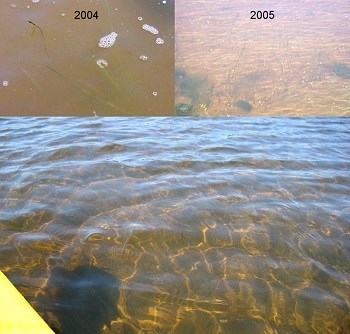
Water quality Since opening the existing culvert to tidal flow, salinities in the lagoon have climbed to around 20 ppt (winter) and 30 ppt (summer). Dissolved oxygen concentrations also have improved and although there are still periods of low or no bottom water oxygen that may adversely impact benthic communities, there have been no more fish kills like those witnessed before the restoration. Temperatures are fairly warm, with maximum values reaching ~30C (86F) in the summer. Perhaps the most conspicuous change in the water quality of East Harbor has been the increase in water clarity (large image). What was once a very turbid lake with almost no visibility has turned into a very clear, well-lit estuary. Finally, the sandy bottom can be seen through clear water across the entire lagoon.
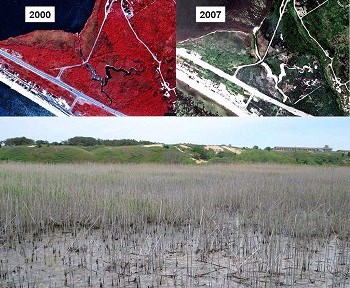
Vegetation Although partial tidal restoration has allowed salinities to approach levels normally found in salt marsh ecosystems, there is still not enough tidal amplitude in East Harbor for salty water to penetrate into much of the peripheral marsh area. As a result, changes in floodplain vegetation have mostly been limited to the Moon Meadow area where seawater first enters the system. There, low-lying areas of cattail and Phragmites have been salt-killed (large image). 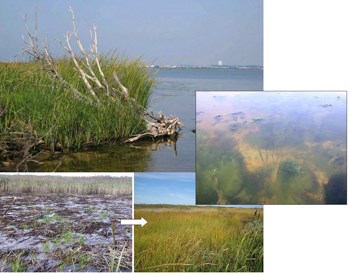
Planting and seeding efforts by NPS staff and Americorps volunteers has resulted in successful establishment and subsequent expansion of native salt marsh species to replace the salt killed plants (large image). In the lagoon itself, seagrasses - both widgeongrass (Ruppia maritima) and eelgrass (Zostera marina) - have flourished. In recent years, however, this positive development has been tempered by the proliferation of macroalgae. Although macroalgae is a normal component of coastal systems (e.g., it is abundant in Nauset Marsh), it has reached nuisance levels at times in East Harbor - particularly in 2006 when a large bloom occurred. Since that time, macroalage has declined somewhat. 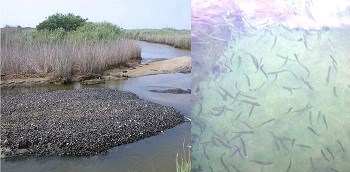
Fauna Prior to restoration, only Asian carp, white perch, American eels, and alewives were able to survive in East Harbor. With the re-introduction of seawater came an explosion in biodiversity (large image). A host of marine/estuarine organisms now inhabit East Harbor, including sticklebacks, silversides, mummichogs, pipe fish, winter flounder, blue mussels, hard clams, soft shelled clams, oysters, shrimp, horseshoe crabs, sea anemones, sea squirts, and many more 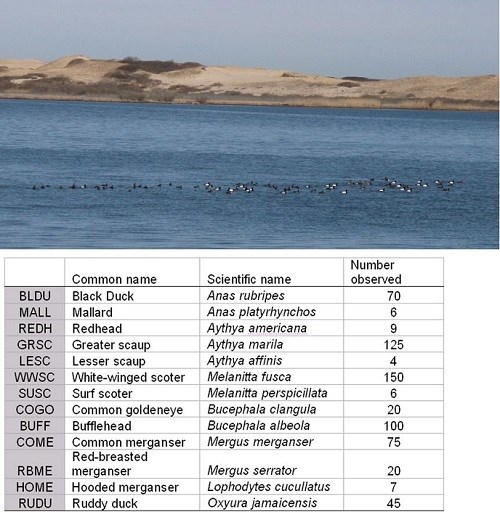
Prior to restoration, waterfowl use was limited to small flocks of black ducks, red-breasted mergansers and buffleheads. But in recent years, flocks of hundreds of bay and sea ducks, representing at least 13 species, have been observed using East Harbor during the winter months. The first indication of a radical increase in wintering duck use came from a 2006 Christmas bird count reported by Jan Smith of the Massachusetts Coastal Zone Management Office. These birds continued to use the lagoon throughout the 2006-2007 winter, season (except during periods of high ice cover). Most species were observed to dive regularly, likely feeding on benthic animals, with mergansers probably feeding on the many small fish that have populated the system. Dabbling ducks like mallards and black ducks feed on a combination of animals (e.g. shellfish) and submerged plants (seagrasses). Increased waterfowl use is expected to continue, so long as at least the existing culvert connecting the system with Cape Cod Bay remains open. Casual observations in the fall of 2007 indicated use by several hundred sea and bay ducks, predominantly lesser scaups, white-winged scoters, surf scoters and buffleheads (large image). |
Last updated: February 26, 2015
